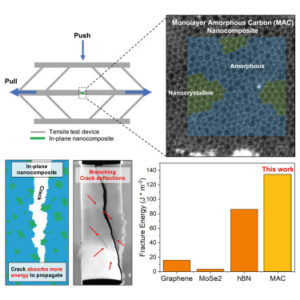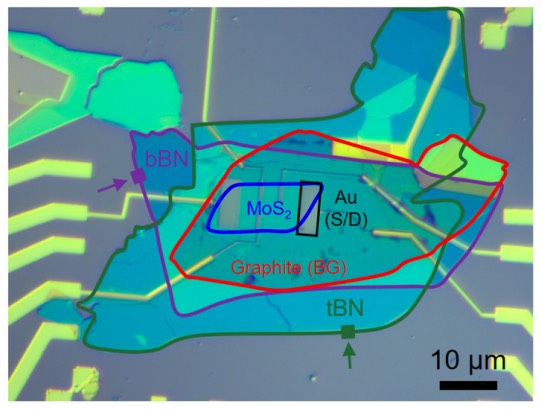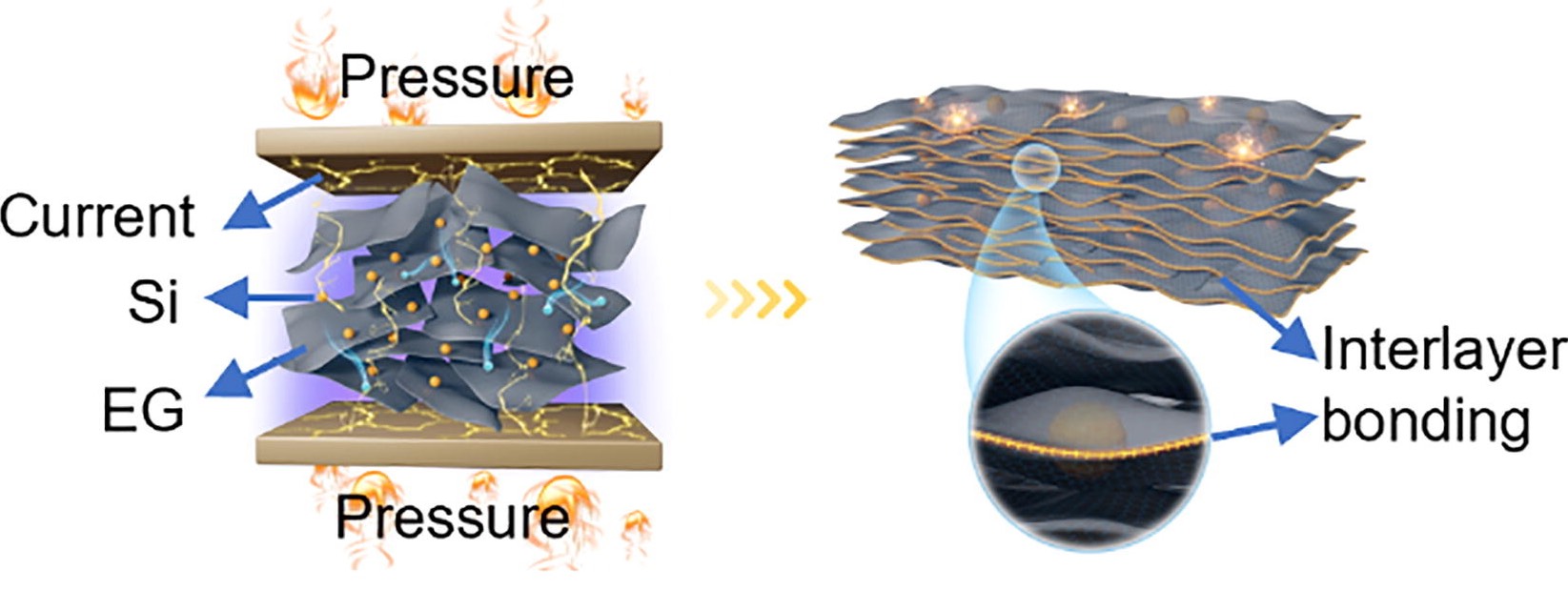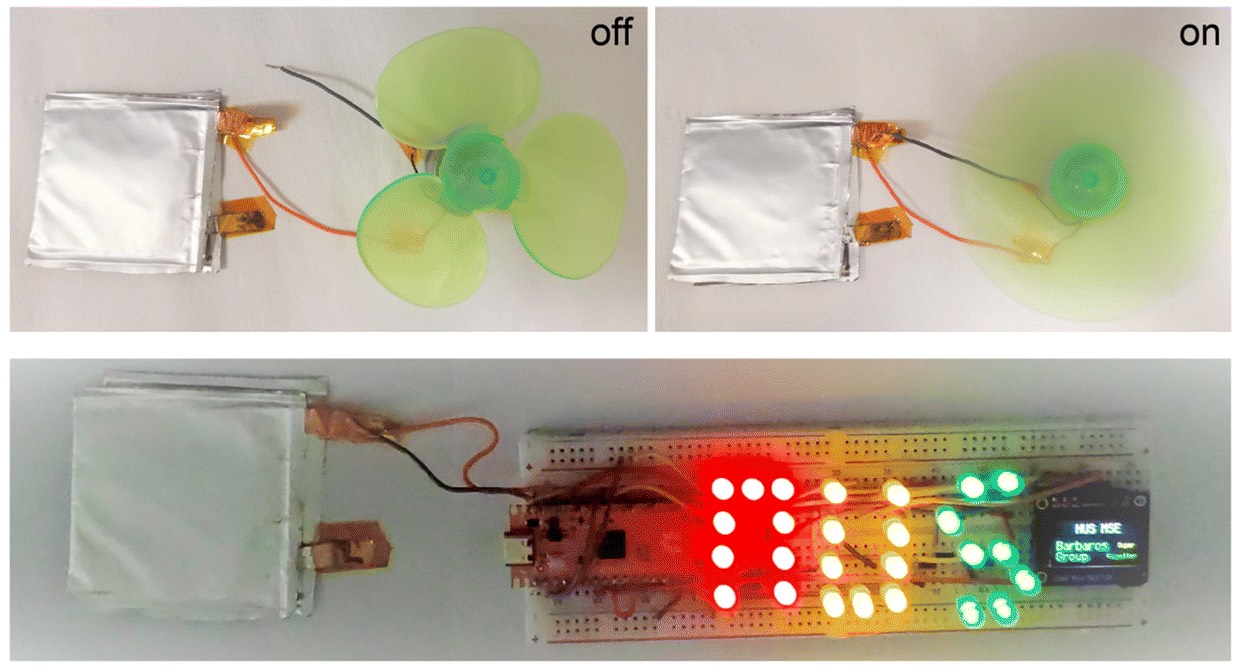Superior Adhesion of Monolayer Amorphous Carbon to Copper
The single-atom thickness of graphene holds great potential for device scaling, but its effectiveness as a thin metal-ion diffusion barrier in microelectronics and a corrosion barrier for plasmonic devices is compromised by weak van der Waals interactions with copper (Cu), leading to delamination issues. In contrast, monolayer amorphous carbon (MAC), a recently reported single-atom-thick carbon film with a disordered sp2 hybridized structure, demonstrates superior adhesion properties. This study reveals that MAC exhibits an adhesion energy of 85 J m−2 on Cu, which is 13 times greater than that of graphene. This exceptional adhesion is attributed to the formation of covalent-like Cu─C bonds while preserving its sp 2 structure, as evidenced by X-ray photoelectron spectroscopy (XPS) and near-edge X-ray absorption fine structure(NEXAFS) spectroscopy. Density functional theory (DFT) calculations further elucidate that the corrugated structure of MAC facilitates the hybridization of C 2p z orbitals with Cu 4s and 3dz 2 orbitals, promoting strong bonding. Theseinsights indicate that the amorphous structure of MAC significantly enhances adhesion while preserving its elemental composition, providing a pathway to improve the mechanical reliability and performance of two-dimensional(2D) materials on metal substrates in various technological applications.

This work is with several international collaborators. For more details, please refer to the link.
Despite the superior properties of two-dimensional (2D) materials, their low fracture toughness has limited practical applications. Our study demonstrates intrinsic toughening in monolayer amorphous carbon (MAC) nanocomposites predominantly composed of amorphous phases with small crystalline domains, showing significant enhancements in energy absorption during crack propagation. These improvements are quantitatively investigated through in situ SEM tensile testing and molecular dynamics (MD) simulations. This work not only unveils the toughening mechanisms but also introduces an intrinsic toughening strategy for 2D materials, enabling their use in fields requiring robust fracture resistance.

This work is with several international collaborators. For more details, please refer to the link.
Plasmonic tunnel junctions are a unique electroluminescent system in which light emission occurs via an interplay between tunnelling electrons and plasmonic fields instead of electron–hole recombination as in conventional light-emitting diodes. It was previously shown that placing luminescent molecules in the tunneling pathway of nanoscopic tunnel junctions results in peculiar upconversion electroluminescence where the energy of emitted photons exceeds that of excitation electrons. Here we report the observation of upconversion electroluminescence in macroscopic van der Waals plasmonic tunnel junctions comprising gold and few-layer graphene electrodes separated by a ~2-nm-thick hexagonal boron nitride tunnel barrier and a monolayer semiconductor. We find that the semiconductor ground exciton emission is triggered at excitation electron energies lower than the semiconductor optical gap. Interestingly, this upconversion is reached in devices operating at a low conductance (<10−6 S) and low power density regime (<102 W cm−2), defying explanation through existing proposed mechanisms. By examining the scaling relationship between plasmonic and excitonic emission intensities, we elucidate the role of inelastic electron tunnelling dipoles that induce optically forbidden transitions in the few-layer graphene electrode and ultrafast hot carrier transfer across the van der Waals interface.

This work is lead by Prof. Goki Eda’s group with contribution from Prof. Barbaros’ group. For more details, please refer to the link.
We report a new nanoporous amorphous carbon (NAC) structure that achieves both ultrahigh strength and high electrical conductivity, which are usually incompatible in porous materials. By using modified spark plasma sintering, we create three amorphous carbon phases with different atomic bonding configurations. The composite consists of an amorphous sp2-carbon matrix mixed with amorphous sp3-carbon and amorphous graphitic motif. NAC structure has isotropic electrical conductivity of up to 12,000 S/m, a Young’s modulus of up to ∼5 GPa, and Vickers hardness of over 900 MPa. These properties are superior to those of existing conductive nanoporous materials. Direct investigation of the multiscale structure of this material through transmission electron microscopy (TEM), electron energy loss spectroscopy (EELS), and machine learning-based electron tomography revealed that the origin of the remarkable material properties is the well-organized sp2/sp3 amorphous carbon phases with a core-shell-like architecture, where the sp3-rich carbon forms a resilient core surrounded by a conductive sp2-rich layer. Our research not only introduces novel material with exceptional properties, but also opens new opportunities for exploring amorphous structures and designing high-performance materials.

This breakthrough opens up new possibilities in energy storage, with implications for a wide range of industries. We are incredibly proud of our team’s dedication and hard work in making this achievement possible. For more details, please refer to the link. Let’s continue pushing boundaries and driving innovation together!
We investigate the magnetoresistance of a dual-gated bilayer MoS2 encapsulated by hexagonal boron nitride. At low magnetic fields (|B|<0.5T), we observe a negative magnetoresistance, which we identify as the weak localization effect. We determine both the phase coherence length and mean free path as a function of electron density and displacement field. Both characteristic lengths show a similar monotonic increase with electron density, while they are not affected by the displacement field. We further investigate the dephasing mechanism by measuring the temperature dependence of the phase coherence length. Our results suggest that when only the lower spin-orbit split bands (K↑, K′↓) contribute to transport is Coulomb scattering the dominant source of decoherence, while intervalley scattering seems not to play a relevant role in this regime. This observation is consistent with the picture of spin-polarized valleys (spin-valley locking), where the intrinsic spin-orbit coupling protects the spin states, rather than introducing an additional dephasing mechanism as in other materials.

Despite advancements in silicon-based anodes for high-capacity lithium-ion batteries, their widespread commercial adoption is still hindered by significant volume expansion during cycling, especially at high active mass loadings crucial for practical use. The root of these challenges lies in the mechanical instability of the material, which subsequently leads to the structural failure of the electrode. Here, we present a novel synthesis of a composite combining expanded graphite and silicon nanoparticles. This composite features a unique interlayer-bonded graphite structure, achieved through the application of a modified spark plasma sintering method. Notably, this innovative structure not only facilitates efficient ion and electron transport but also provides exceptional mechanical strength (Vickers hardness: up to 658 MPa, Young’s modulus: 11.6 GPa). This strength effectively accommodates silicon expansion, resulting in an impressive areal capacity of 2.9 mA h cm−2 (736 mA h g−1) and a steady cycle life (93% after 100 cycles). Such outstanding performance is paired with features appropriate for large-scale industrial production of silicon batteries, such as active mass loading of at least 3.9 mg cm−2, a high-tap density electrode material of 1.68 g cm−3 (secondary clusters: 1.12 g cm−3), and a production yield of up to 1 kg per day.

This breakthrough opens up new possibilities in battery technology, with implications for a wide range of industries. We are incredibly proud of our team’s dedication and hard work in making this achievement possible. For more details, please refer to the link. Let’s continue pushing boundaries and driving innovation together!
In anisotropic crystals, the direction-dependent effective mass of carriers can have a profound impact on spin transport dynamics. The puckered crystal structure of black phosphorus leads to direction-dependent charge transport and optical response, suggesting that it is an ideal system for studying anisotropic spin transport. To this end, we fabricate and characterize high-mobility encapsulated ultrathin black-phosphorus-based spin valves in a four-terminal geometry. Our measurements show that in-plane spin lifetimes are strongly gate tunable and exceed one nanosecond. Through high out-of-plane magnetic fields, we observe a fivefold enhancement in the out-of-plane spin signal case compared to in-plane and estimate a colossal spin-lifetime anisotropy of ∼6. This finding is further confirmed by oblique Hanle measurements. Additionally, we estimate an in-plane spin-lifetime anisotropy ratio of up to 1.8. Our observation of strongly anisotropic spin transport along three orthogonal axes in this pristine material could be exploited to realize directionally tunable spin transport.
This breakthrough opens up new possibilities in battery technology, with implications for a wide range of industries.We are incredibly proud of our team’s dedication and hard work in making this achievement possible. For more details, please refer to the link. Let’s continue pushing boundaries and driving innovation together! 🔗
Zinc metal-free zinc-ion batteries hold promise for achieving higher energy densities by eliminating the need for dense zinc foil as the anode. However, the direct use of substrates like copper foil in these batteries results in poor cyclic stability due to dendrite growth. Herein, we propose a strategy to modulate the nucleation sites and growth dynamics of Zn. This is achieved by introducing a graphene coating on the copper substrate, which directs the initial nucleation of Zn to form hexagonal plates. Subsequently, the incorporation of positively polarized poly(vinylidene fluoride-trifluoroethylene) promotes growth along these hexagonal plates, resulting in uniform crystalline plates. As a result, the half-cell demonstrated a significant improvement in the cyclic life of 3000 cycles at a high current density of 10 mA cm−2 and capacity of 1 mA h cm−2. When paired with Zn-inserted MnO2 cathode, the full cell exhibited high cyclic stability (retaining 83% capacity after 500 cycles at 1 mA cm−2) and energy density of 378 W h kg−1 at 0.5 mA cm−2. This is notably higher than the conventional Zn ion battery based on a Zn anode (136 W h kg−1). To showcase its potential, we prepared a pouch cell that successfully powered the electric fan and LED lights, suggesting its promising application in high-performance Zn ion batteries.

Bulk amorphous materials have been studied extensively and are widely used, yet their atomic arrangement remains an open issue. Although they are generally believed to be Zachariasen continuous random networks, recent experimental evidence favours the competing crystallite model in the case of amorphous silicon. In two-dimensional materials, however, the corresponding questions remain unanswered.
Here we report the synthesis, by laser-assisted chemical vapour deposition, of centimetre-scale, free-standing, continuous and stable monolayer amorphous carbon, topologically distinct from disordered graphene. Unlike in bulk materials, the structure of monolayer amorphous carbon can be determined by atomic-resolution imaging. Extensive characterization by Raman and X-ray spectroscopy and transmission electron microscopy reveals the complete absence of long-range periodicity and a threefold-coordinated structure with a wide distribution of bond lengths, bond angles, and five-, six-, seven- and eight-member rings. The ring distribution is not a Zachariasen continuous random network, but resembles the competing (nano)crystallite model.
We construct a corresponding model that enables density-functional-theory calculations of the properties of monolayer amorphous carbon, in accordance with observations. Direct measurements confirm that it is insulating, with resistivity values similar to those of boron nitride grown by chemical vapour deposition. Free-standing monolayer amorphous carbon is surprisingly stable and deforms to a high breaking strength, without crack propagation from the point of fracture.
The excellent physical properties of this stable, free-standing monolayer amorphous carbon could prove useful for permeation and diffusion barriers in applications such as magnetic recording devices and flexible electronics.
After the first unequivocal demonstration of spin transport in graphene [Tombros et al., Nature (London) 448, 571–574 (2007)], surprisingly at room temperature, it was quickly realized that this novel material was relevant for both fundamental spintronics and future applications. In the decade since, exciting results have made the field of graphene spintronics blossom, and a second generation of studies has extended to new two-dimensional (2D) compounds. This Colloquium reviews recent theoretical and experimental advances on electronic spin transport in graphene and related 2D materials, focusing on emergent phenomena in van der Waals heterostructures and the new perspectives provided by them. These phenomena include proximity-enabled spin-orbit effects, the coupling of electronic spin to light, electrical tunability, and 2D magnetism.
